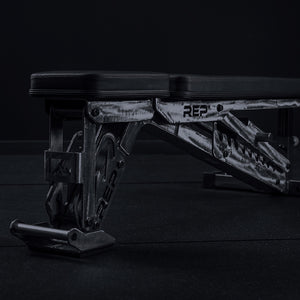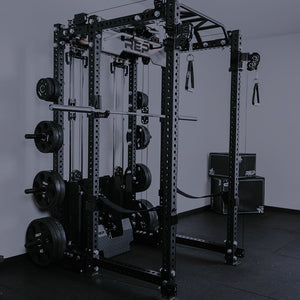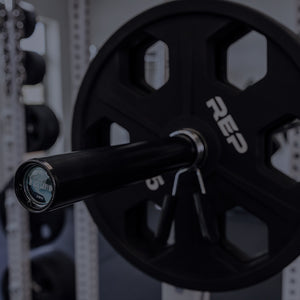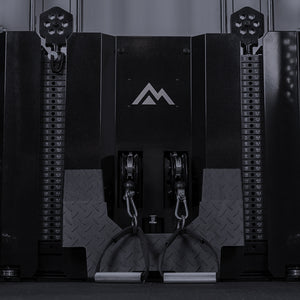
Biceps, lats, quads, all day. But you don’t see a ton of buff fingers on Flex Friday.
While it’s not as exciting to show off your hand gainz as it is to get a bicep pump, really, it should be. Your grip strength is a real predictor of your overall muscular strength, endurance, and other health factors, according to the Journal of Strength and Conditioning Research. Other studies found a correlation between grip strength and a reduced risk of stroke and heart attack -- and even your mortality risk.
THE IMPORTANCE OF STRONG GRIP

Grip strength may be easy to relate to sports like golf, tennis, rock climbing, baseball, aerial dance, pole fitness, and gymnastics, but it’s also a critical piece of how much weight you can lift in the gym. This becomes especially true with barbell exercises, like deadlifts, rows, and snatches, as well as pull-ups.
In fact, the most limiting factor in many workouts isn’t the muscles you're trying to hit; it’s your ability to hold the weight. While wrist straps can help assist grip, they can only do so much, and they don’t address the root issues. Plus, you can’t use straps in some competitions, like a sanctioned powerlifting meet.
If you want to move more weight, you also need to train your wrists, hands, and forearms. Your grip can also provide insight into what’s happening with the rest of your body. If your grip suddenly feels weak in the gym, that can indicate a fatigued central nervous system and hormonal fatigue. In other words, it may be time for a deload week.
DIFFERENT GRIP OPTIONS
There are several different ways to hold a barbell that hit your grip differently. We'll detail each grip, how to do it, and what it's good for.
Overhand Grip

The most common way to grab a bar is overhand – with both hands facing down. Overhand grip is a great way to train forearm and hand strength, so some trainers recommend using this as long as possible during warm-ups. You can also flip them around for underhand exercises, with both palms facing upward.
Split Grip
Heavy deadlifts are the easiest way to see how grip affects how much weight you can pull. Your proportionately small fingers get exhausted containing that much weight and they lose grip of the bar long before you hit your true max. This is why many powerlifters practice split grip or hook grip.
Split grip or mixed grip is where one hand is positioned overhand and the other is underhand. Typically, your dominant hand handles the overhand position. The tension between the different grip directions creates more security around the bar.
But obviously, this grip is imbalanced and can therefore lead to problems if you aren’t diligent in switching which hand is overhand and which is underhand.
Hook Grip
The risk of creating muscular imbalances is why experienced powerlifters may opt for hook grip, where your fingers lock around your thumb, which is tucked underneath them. Hook grip is symmetrical and secure – but it hurts. The pain keeps many lifters away from this option, although just like any exercise, you can train your tolerance to hook grip. Just keep practicing.
Snatch Grip
Then there’s snatch grip, more common among Olympic weightlifters. This wider hand position demands more of your upper back than a narrower barbell grip position. Each lifter’s specific width varies based on their size.
HOW TO IMPROVE YOUR GRIP

Just like any muscle, you gotta train your grip to improve it. This means choosing overhand grip whenever possible and skipping the straps.
You can also train with a fatter Axle Bar, which is a common piece of equipment in Strongman. These bars are thicker than a standard barbell and much harder to hold onto, because most people can’t fully close their hands.
Other ways to improve your grip:
- Practice dead hangs from your pull-up bar.
- Do pull-ups with different hand positions on a multi-grip bar.
- Incorporate farmer’s carries into your workout
- Try reverse bicep curls.
- Accept your callouses. They’re your friends. But to keep them from tearing, you may want to occasionally file them down.
- Do wrist curls and reverse wrist curls.
- Play with the Battle Ropes. And rope climbs.
- Pick up some hand grippers and squeeze.
- Do sled pulls using a rope attached to the sled.
- Practice your pinches. Pick up and hold a heavy plate between your fingers. How about two?
- Do pull-ups or chin-ups while holding onto a towel draped over the pull-up bar.
- Practice push-ups on your fingers.
- Also don’t forget to stretch your wrists, fingers, and forearms to improve mobility.
- If you still need a grip boost and you suffer from sweaty palms, you can always throw on a little chalk for your heavy sets.
A LOOK AT GRIP SPORTS
Grip is so important in strength sports that it even has its own sanctioned competitions. Grip Sport International heads these up.
In grip sport, you often consider three different types of grip strength: crushing (closing your fingers around something), pinching (with the thumbs and fingers), supporting (lifting something with your fingers).
Grip competitions may also include other measurements of grip strength, including vertical grip (with the wrist bent), bending (like bending nails), and tearing, among others.
In addition to common gym equipment, grip sport athletes train on specialized equipment. These include the likes of Napalm’s Nightmare (a sort of deadlift with a short, fat, rotating handle), a pinch block (a metal block attached to weight that you pick up between your fingers and thumb), grippers (a grip trainer you’re probably familiar with), and hubs (a shallow, round apparatus attached to weight that you lift with just the tips of your fingers).
Takeaway
Grip strength is often the limiting factor in many lifts. While you can choose to work with lifting straps and a variety of grips to help you complete your lifts, you'll be losing out on giving your wrist flexors, forearms, and grip the training it needs.
When tackling your lifts, try various grip styles to see what works best for you and your goals. Because a better grip translates to a better lift.
similar to this

NEWSLETTER SIGNUP
Product launch information, promotions, blogs, and REP news.








